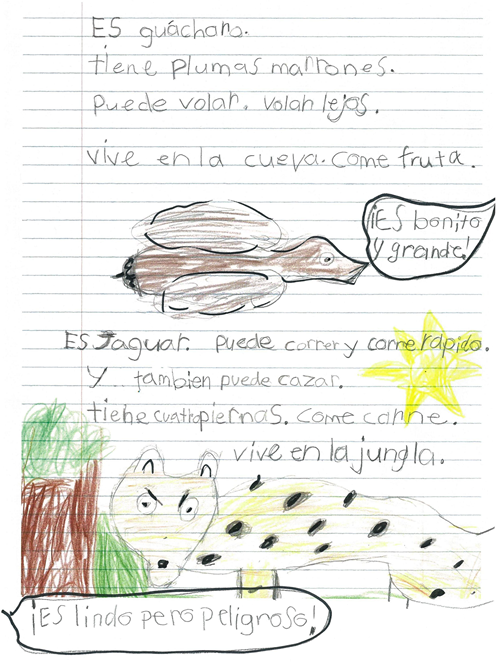Languages: Spanish - Satisfactory - Years 3 and 4
Portfolio summary
This portfolio of student work shows that the student can interact with teachers (WS5) and peers (WS3, WS4, WS6) in classroom routines (WS2, WS5), and in action-related talk and play (WS7, WS8). The student uses formulaic expressions when participating in classroom routines (WS2) and collaborative activities (WS7, WS8), such as complimenting others, requesting help and seeking permission. The student interprets visual, non-verbal and contextual cues such as intonation (WS8), gestures and facial expressions to help make meaning (WS2, WS7). The student makes statements using the present tense (WS3, WS4, WS8) and the present + infinitive form (WS1) about aspects of their lives (WS2, WS3) such as school, home (WS4) and everyday routines (WS5, WS6). The student approximates Spanish pronunciation and intonation in simple statements (WS2, WS4 WS5, WS6, WS7, WS8). The student gathers information (WS8) relating to own and others’ lifestyles and presents information at sentence level in simple texts (WS1, WS2, WS3, WS4, WS5, WS6). The student makes simple statements (WS2) about characters, themes and their own reactions in response to imaginative texts. The student uses modelled sentence structures to compose short original texts (WS2, WS3) using conjunctions and prepositions (WS1, WS5, WS6). The student uses vocabulary related to school, home and lifestyles (WS2, WS3, WS4, WS5, WS6, WS7, WS8). The student uses possessive adjectives, adjectives, singular and plural forms (WS3, WS8) and regular verbs in simple constructions (WS1, WS2, WS4, WS5). When writing, the student applies punctuation and capitalisation rules (WS1, WS2). The student translates short texts, using word lists (WS5) and dictionaries and creates simple bilingual texts (WS3). The student uses simple phrases and expressions that reflect cultural practices, for example, diminutives.
The student differentiates between statements, commands, exclamations and questions according to intonation (WS2, WS4, WS7, WS8). The student identifies similarities and differences between some Spanish and English texts (WS4), recognising that familiar texts have characteristic features. The student gives examples of how language use varies according to the age, gender and relationship of participants, and of ways that languages change over time. The student names some of the many languages that are spoken in Australia, and identifies languages represented in the class and local community. The student identifies ways in which the cultures of Spanish speakers influence everyday interactions, involving greetings and polite expressions (WS7).







